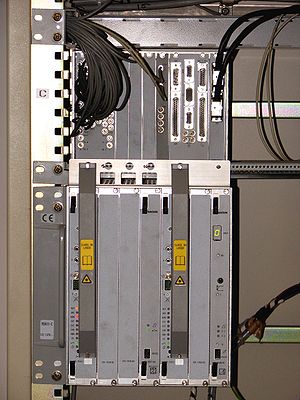
Add-drop multiplexer
Encyclopedia

Optical fiber
An optical fiber is a flexible, transparent fiber made of a pure glass not much wider than a human hair. It functions as a waveguide, or "light pipe", to transmit light between the two ends of the fiber. The field of applied science and engineering concerned with the design and application of...
network. A multiplexer
Multiplexer
In electronics, a multiplexer is a device that selects one of several analog or digital input signals and forwards the selected input into a single line. A multiplexer of 2n inputs has n select lines, which are used to select which input line to send to the output...
combines, or multiplexes
Multiplexing
The multiplexed signal is transmitted over a communication channel, which may be a physical transmission medium. The multiplexing divides the capacity of the low-level communication channel into several higher-level logical channels, one for each message signal or data stream to be transferred...
, several lower-bandwidth
Bandwidth (computing)
In computer networking and computer science, bandwidth, network bandwidth, data bandwidth, or digital bandwidth is a measure of available or consumed data communication resources expressed in bits/second or multiples of it .Note that in textbooks on wireless communications, modem data transmission,...
streams of data into a single beam of light
Light
Light or visible light is electromagnetic radiation that is visible to the human eye, and is responsible for the sense of sight. Visible light has wavelength in a range from about 380 nanometres to about 740 nm, with a frequency range of about 405 THz to 790 THz...
. An add-drop multiplexer also has the capability to add one or more lower-bandwidth signals to an existing high-bandwidth data stream, and at the same time can extract or drop other low-bandwidth signals, removing them from the stream and redirecting them to some other network path. This is used as a local "on-ramp" and "off-ramp" to the high-speed network.
ADMs can be used both in long-haul core networks and in shorter-distance "metro
Metropolitan area
The term metropolitan area refers to a region consisting of a densely populated urban core and its less-populated surrounding territories, sharing industry, infrastructure, and housing. A metropolitan area usually encompasses multiple jurisdictions and municipalities: neighborhoods, townships,...
" networks, although the former are much more expensive due to the difficulty of scaling the technology to the high data rates and dense wavelength division multiplexing (DWDM) used for long-haul communications. The main optical filtering technology used in add-drop multiplexers is the Fabry–Pérot etalon.
A recent shift in ADM technology has introduced so-called "multi-service SONET/SDH" (also known as a multi-service provisioning platform or MSPP) equipment which has all the capabilities of legacy ADMs, but can also include cross-connect functionality to manage multiple fiber rings in a single chassis. These new devices can replace multiple legacy ADMs and also allow connections directly from Ethernet
Ethernet
Ethernet is a family of computer networking technologies for local area networks commercially introduced in 1980. Standardized in IEEE 802.3, Ethernet has largely replaced competing wired LAN technologies....
LAN
Län
Län and lääni refer to the administrative divisions used in Sweden and previously in Finland. The provinces of Finland were abolished on January 1, 2010....
s to a service provider's optical backbone.
In the end of 2003, sales of multiservice ADMs exceeded those of legacy ADMs for the first time, as the change to next-generation SONET/SDH networks accelerated.
An emerging variety of ADMs that is becoming popular as the carriers continue to invest in metro optical networks are reconfigurable optical add-drop multiplexer
Reconfigurable optical add-drop multiplexer
In fiberoptics, a reconfigurable optical add-drop multiplexer is a form of optical add-drop multiplexer that adds the ability to remotely switch traffic from a WDM system at the wavelength layer. This is achieved through the use of a Wavelength selective switching module...
s (ROADMs).

